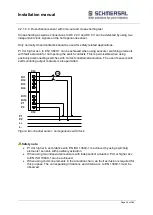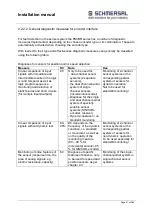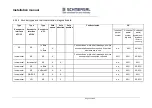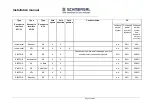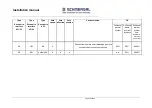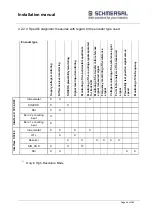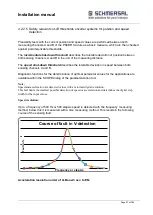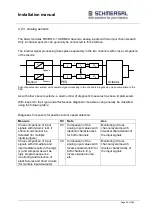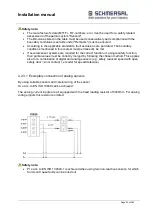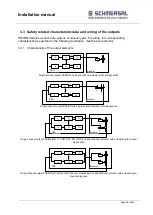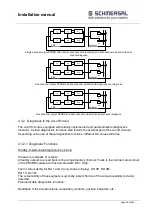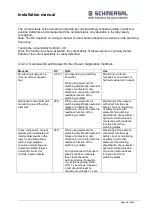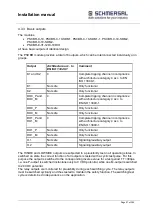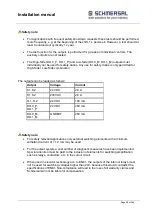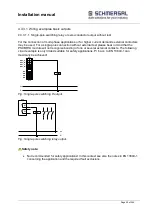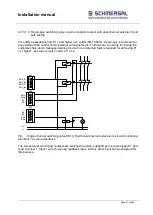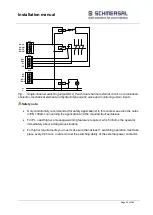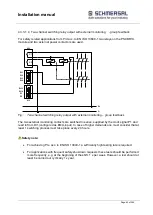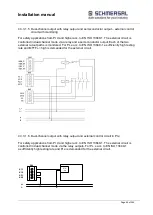
Installation manual
Page 50 of204
4.2.2.6 Safety related assessment of encoder types or there combination
Due to the monitoring functions implemented in the PSCBR-series, no special demands are
initially made on the internal design of the encoder electronics in applications with encoder
systems, i.e. standard encoders can normally be used.
A safety related assessment of the overall arrangement must generally be made. Data issued by
the encoder manufacturer (FIT, MTTF) as well as the DC from the table in 4.2.2 must in this case
be used.
When using individual encoders at least an fault exclusion for the mechanical actuating chain, as
well as for the single-channel part of must be made under due consideration of the applicable
specification in EN 13849-1. Furthermore, the information in 4.2.2 must also be observed.
PI d and higher acc. to EN 13849-1 is normally reached by a combination of two encoders with
prioritized different technology and separated mechanical linking.
The use of compact encoders with internal 2-channel structure of different technology is also
suitable for applications up to PI e acc. to EN 13849-1, however, under due consideration of the
specifically required fault exclusions and their permissibility. Normally one should use encoders
with proven safety related characteristics, the safety level of which meets the demanded level.
Safety note:
They use of standard encoders or a combination of standard encoders is permitted. For
the overall arrangement consisting of encoder,. further sensors/switching elements for
triggering the safety function, the PSCBR-module and their cut-off channel a safety
related assessment is strictly required. For determining the achieved safety level one
needs, among others, information from the manufacturer (FIT, MTTF) and the DC as
specified under 4.2.2.
If only one encoder is used, the fault exclusion "shaft breakage / fault in the mechanical
encoder connection" is required. Suitable measures must be applied for this purpose, e.g.
a positive connection of the encoder by means of slot shim or locking pin. The applicable
information issued by the manufacturer as well as EN 138549-1 with respect to
requirements and permissibility of the fault exclusion must strictly be followed.
Encoders with proven safety related characteristics must preferably be used as individual
encoders. The safety level of these encoders must at least meet the intended safety level
of the overall arrangement. The information of the manufacturer with respect to diagnostic
measures, mechanical connection and measures for the voltage supply must be strictly
followed.
SIN/COS encoder: The internal structure of the sensor system must be designed in such
a way, that output signals for both tracks can be generated independently from each other
and Common-Cause faults can be ruled out. Evidence of the mechanical design, e.g.
fastening of the code disc on the shaft, must also be provided. Encoders with proven
safety related characteristics should preferably be used.
When using compact encoders with internal dual-channel structure, such as e.g. SSI +
incremental/SinCos, you must strictly follow the instructions of the manufacturer
concerning safety related characteristics, diagnostic measures, mechanical connection
and measures concerning the electric power supply. The safety level of the encoder must
at least meet the intended safety level of the overall arrangement. Encoders with proven
safety related characteristics should preferably be used.
Summary of Contents for PSCBR-C-10 Series
Page 1: ...Installation manual Page 1 of204 Installation Manual For PSCBR modules Series PSCBR C 10...
Page 178: ...Installation manual Page 178 of 204...
Page 181: ...Installation manual Page 181 of 204 Example for a risk analysis Gefahrenanalyse Risk analysis...

